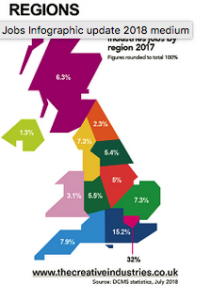Over 90% of the creatives industries in the UK are micro-companies under four people or freelancers. Many do not show up in government statistics, many are University graduates from the numerous Arts and Media courses, most are struggling to survive, and most are engaged in servicing other parts of the UK, and global, economies. This points to a major talent wastage and a loss of Intellectual Property rights, but also a golden economic opportunity, if these creative people can be better supported and helped to not only survive, but grow.
The question is how do you support such a diverse, and fragmented, group of people? And in the first instance how do you find them?
In this blog we set out some answers to the latter question as the basis of answering the first. You cannot support and develop creative work if you do not know who in your area is doing it, and what type of support they need.
Creative Clusters Research to date
NESTA’s Creative Nation map gives a good overview of the level of creative companies and individuals, who are working in each area of the the UK. However. it is only an overview culled from government statistics and meet-up groups etc. To engage with creatives in your area a much more detailed and specific piece of research needs to be undertaken. The new AHRC backed creative clusters may undertake some of this work, but as was indicated in ‘Where Are the AHRC Creative Clusters?’ these are often sector specific e.g. fashion, and in many cases, not even located in one geographical area.

The AHRC’s FUSE programmes looked at how local creative businesses worked and grew, and highlighted the unmet needs of freelancers and micro-companies. Though focussed on Brighton and Newcastle the FUSE insights were supported by the national CIF Freelance Survey in 2017. Both pieces of research highlighted the needs of the creatives but were urban-centric, and neither provided a model for local research, which reaches out across the whole sector from makers and visual artists to designers and VR creators.
The Local Approach
Several local authorities have declared their intention to support the creative industries e.g. West Midlands Combined Authority, and the success of Hull’s ‘City of Culture’, etc., has shown the impact of an arts focus in growing local economies. However some have gone one stage further and undertaken very local research. One of the most recent was Lambeth Council, in London. Lambeth’s ‘A Creative Way to Grow’ includes a description of how they surveyed their local creative community, and thus arrived at a targeted local strategy. Westminster City council, another London Council, who had also undertaken a creative review ten years earlier, recently held a Media Forum looking at the next steps they will take following this research. So what lessons can we take from their approach to discovering the creatives on your doorstep?

Initial Research
This screen/desk-based period concentrates on a literature review covering everything from the NESTA type publications to government economic publications e.g Nomis, Creative Industry Council, Creative Industries Federation and TechUK material plus Local Enterprise Partnership (LEP ) and City Council information. However, input from the Arts Councils, Screen Agencies and the Design and Crafts Councils also need to be factored in. Though there is still an artificial divide in some quarters between Arts, Media and Digital, to know what is happening near you, you need to search for all sectors of the creative industries.
The danger in this early stage is to prejudge what is happening. Your area may be well known for games, tech companies or visual arts, but is very unlikely this is all that is happening, and focusing on what is already known will miss many opportunities.
The Scale of the Research
The quantitative element of the research will depend very much on how thorough you are with the follow up to this initial survey of what is happening. The key is not to stop with web and the recognised networks. It is very unlikely that most creative freelancers are members of the Chambers of Commerce or are registered with a LEP. Therefore, reaching out to informal networks e.g. meet-up groups, theatre supporters networks, and commercial hubs e.g. local galleries and craft shops is an essential first step to increasing the database on which the overall strategy will be based.
In Lambeth this involved over 100 organisations, while in Westminster they identified 4,079 business. This latter group were approached, of which 3355 formed the initial base for their research.
Contact
The next stage is all about contacting people. The scale of this will obviously depend on the level of resources available to the research team or individual. It may involve a number of different approaches from telephone surveys, online questionnaires, focus groups, the creation of advisory groups and face-to-face interviews.
One interesting approach to gathering creatives together given the pressures on their time, their lack of money and network opportunities, is the idea of creative breakfasts, or suppers, held in local cafes and restaurants. This not only provides an informal and local meeting point for the people concerned, but also acts as an extra trading opportunity for the venues involved. A more focused Meet-Up style gathering with a key speaker, and funding opportunity announcements can be attractive to creatives with little free time.

The important element of this stage, with regard to future action, is to ascertain what help/resources the creatives need to grow, develop new work, or be more successful?
This is qualitative research at its best. In Lambeth it involved in depth interviews with 40 stakeholders and workshops involving businesses, sector-focused business support bodies, property developers, and education providers. In Westminster, it involved 34 semi-structured face to face interviews, and 600 structured telephone interviews using open and closed questions.
Both research teams used advisory groups from different creative sectors to help devise questionnaires etc.
A Policy Review
Once this level of research has been undertaken it is the right moment to step back and review existing policy in your area. This will range from local planning issues to LEP priorities, from the range of business support offered to existing funding available to creatives. The point is to see how far existing plans etc match up with the requirements stated by the freelancers and micros in your area.
In particular, how do they address the different needs of the four main types of creative enterprise.
1.Creative Services – those companies and individuals who service bigger companies and organisations e.g. web agencies, app developers
2. Creative Content Providers – the creators of videos, animation, illustrations and text for companies and brands.
3. Creative Experiences – companies who provide experiences from galleries to VR and pop-up theatre, from performance venues to hackathons.
4. Creative Originals – those micros and freelancers who produce the one-off products creating unique works, and potential IP revenues from jewellers to authors, from games designers to screen productions.
The Next Steps
The aim of good research is to provide the basis for the next series of actions.
This obviously depends on who you are, and what resources you ave available to follow up on the research. You may be a local authority.
‘BIDs, universities and other sector support bodies can work with the council to build the strength of creative and technology business networks; compete for business support funding, and attract accelerator programmes to the borough’
Lambeth CDI Study 2017
You may be a government supported city or cluster.
“Coventry’s arts and heritage organisations will be helping to tell the stories of Coventry to all the people who visit, live or work here. A key ingredient is collaboration, with new partnerships, new ideas and new events, inspired by the great places and people in Coventry.” – Coventry City of Culture 2021
You may be University or College
“We are proud of our historic industry links, andvalued reputation for developing professional skillsfor modern industry across many specialisms, withour 50 international partners.” City of Glasgow College
Or a Meet-up Group/local arts group or micro-company 0r freelancer
“SMart is a Belgian-based cooperative that provides a one stop shop support service for freelancers, including an innovative salary guarantee fund to ease the problem of late payments.” RSA ‘The Self-Organising Self-Employed’
Having completed the research, the point is to collaborate with others to improve the support and resources available to creative micro-companies and freelancers in your area.
